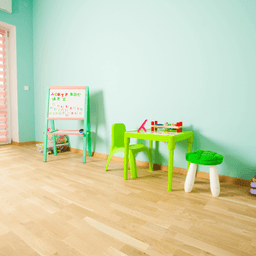How to open a daycare: the ultimate guide [free ebook]
Congratulations! You have decided to start your own daycare center. In this guide, we offer a step-by-step process for building a successful childcare business to help you as you embark on this adventure. We cover making your business plan, budgeting, finding your location, establishing your insurance, policies, and procedures, hiring your team, marketing your center, and so much more!
Opening a daycare center can be a great opportunity for an aspiring entrepreneur who loves children and early learning. Use this handbook as your guide to help walk you through the process! And feel free to reach out if you have any questions. We are here to help you every step of the way!
Table of contents
- Determine demand
- Business plan
- Set budget
- Secure your space
- Choose your name
- Apply for licensing and accreditation
- Get insurance
- Establish your center policies
- Order supplies and furniture
- Purchase management software
- Build your team
- Market your center
- Open your doors
- Grand opening
- Provide high-quality childcare
Before you begin, define your WHY
You are about to embark on a rollercoaster of a journey: Opening your own daycare. There will be countless highs and lows, but the key to navigating through all of them is to remember why you made this decision in the first place.
So, before you even get started in the nitty-gritty, take some time to clearly and precisely define your why. Write it down. Use a vision board, a journal, or the back of a napkin; whatever works! Whatever your medium, keep your WHY handy so that you can look back on it with pride and determination.
Defining Your Why: Getting Started
I am opening a daycare because…
- …I want to provide the best possible experience for children and their parents.
- …I want to share my vision for early childhood education with the world.
- …I care deeply about having a positive influence on childhood development.
Think about what matters most to you when it comes to childcare. What excites you? What are you passionate about? Your WHY may change over time, but no matter what your ultimate destination is, the journey there will be so much harder if you don’t understand your reason for undertaking it in the first place.
Early childhood education can be thankless and exhausting day-to-day, but the benefits it provides for our next generation are immeasurable. Children are our future, and early childhood education fundamentally shapes their development. Providing them with a positive learning environment during their most formative years is essential to helping them become healthy, well-rounded adults. You will be a part of their childhood. And let’s not forget about all of the hard-working parents you are supporting at the same time!
90% of brain growth occurs before a child reaches kindergarten”
At birth, the average baby’s brain is about a quarter of the size of an adult’s brain. A baby’s brain doubles in size in the first year of life and reaches about 80% of adult size by age 3 and 90% – nearly full-grown – by age 5.
Just think for a moment about all the changes taking place in the brain in those few short years. More than a million new neural connections are formed every second during this time, and those connections will determine the person a child grows up to be. The quality of childcare you provide will have a direct impact on which connections get made and what kind of people your children grow up to be.
1. Determine the demand for care in your area
When it comes to the reasons for opening a daycare center, there’s your personal WHY, and there’s the more general one: children need childcare! This may sound obvious, and it is, but believe it or not: some areas that are already so saturated with childcare options for parents that your business will struggle to gain a foothold.
Therefore, as you are scoping out your location, ensure you do thorough research on the potential competition and how you measure up. This is more than just searching for childcare options in your area. Go for a walk around the neighborhoods you’re considering and take note of accessibility during different times of day for both driving and public transit. For any childcare centers you find, take a tour and meet with the Director to ensure you can get all of the information on their service offerings. Check out local churches, community centers, YMCA’s, etc. since they may also offer childcare services.
Determining demand
Steps you can take online:
- Search for “childcare” or “daycare” in your area to identify competitors
- Join local parent groups on social media to gauge interest
- Check local property taxes, health codes, and other regulations that may impact your business
Steps you can take in person:
- Walk/Drive around prospective neighborhoods
- Note locations of nearby parks, playgrounds, and other potential activities
- Tour potential competitors to learn about their offerings
Make sure you find out how many spaces any neighboring centers have available. You need to ensure there will be enough demand for your services once you are open. When you have found a location with the promise of demand, you are ready to move on to the next step!
2. Put together a business plan
Here’s the bad news: writing your business plan will be one of the most time-consuming and mentally exhausting steps toward opening your daycare center. The good news is: if you get this step right, you will have set the tone and direction for a successful business adventure!
When developing your daycare business plan, try to think in a timeframe of 3-5 years. This level of long-term thinking will serve as a map on your way to your goal of establishing a successful daycare business.
Components of a business plan
| Executive Summary | What is your business? |
| Company Overview | What kind of business will you be? |
| Service Description | What are you providing to the community? |
| Market Analysis | Who are your customers/competitors? |
| Marketing Plan | How will you stand out? |
| Operations Plan | How will your business work? |
| Financial Analysis | What are your expected expenses/income? |
| Milestones | How will you measure success? |
| Supporting Documents | How can you back this all up? |
Once you have this completed, make sure you have a business partner or mentor review it as a second set of eyes.
Are you having trouble finalizing your plan? Try the following for help and support!
3. Put together a budget and secure funding
Love it or loathe it, one of the most important parts of running a daycare is maintaining a balanced budget. No matter how great your daycare is, if you’re spending more than you’re bringing it, its days are numbered.
Thorough planning and keeping an eye on your expenses will help you understand exactly where your money is going and suggest ways to improve efficiency.
Get a head start with our free and easy-to-use daycare budget template.
At the most basic level, you’ll need to track the money your daycare center brings in on a yearly basis–referred to as Annual Recurring Revenue or ARR–and the money it spends regularly (operating expenses) and for one-offs, such as purchasing new playground equipment (capital expenses). Getting into the details, however, this process begins to get a little tricky. When you factor in everything you need to spend money on — from crayons and dish soap to salaries and rent — costs will begin to add up quickly.
Make sure you’ve built your budget in such a way that you can answer these kinds of questions:
- Which items are essential to running my business and which are nice to have?
- How many children will I need to enroll to sustain my business?
- How much will I need to charge in order to cover all of my costs?
Whether you’re an accounting wiz or your eyes glaze over when faced with a spreadsheet, don’t worry: budgeting can be done by anyone. As long as you carefully think things through and list everything out, line-by-line, you’ll be able to create a budget that works for you.
HiMama’s budget template was designed to help you list and analyze your income and expenses. In this Excel file, you will find three sections: Summary, Income, and Expenses.
Formulas are included throughout to help you make calculations easier and play with the numbers to determine a budget that works for your business.
4. Secure your space
Once you have determined the demand for your daycare center and your budget, you are ready to secure your location! If you are planning on using your home, this part is easy! Check out our separate free guide specifically about starting a home daycare.
If you’re planning on purchasing property or you’re applying for a loan to get started, your business plan should contain all the information you need. If you are looking for a space to lease or rent, ensure from your budget that you know what you can afford on a monthly basis, and be mindful of the rate at which your rent may increase. Be sure to consider alternatives to commercial real estate, such as churches, community centers, and schools, as many of these places will have rooms available with affordable rent. Search online (try private groups and newspapers!) and also ask around in your community for recommendations.
Once you have found a spot that seems like a good fit, be sure to check with your local licensing guidelines to ensure it will get approved for childcare. Ideally, your business will be centrally located, accessible to caregivers and children alike, while also being safe and affordable. We all know how difficult the real estate market can be, so get started as early as you can to give yourself lots of time to find the perfect place for your daycare.
5. Choose your name
This is the fun part! You might have something that came to mind right away that’s very meaningful to you, or this might be the kind of thing that you go back and forth on, feeling like you just can’t get “the one” nailed down. Whatever the case, here are a few points to keep in mind:
- Google potential names and consider how they would perform in online searches
- Consider how your business name might be abbreviated or translated
6. Apply for licensing and accreditation
This process varies depending on your state and province. Make sure you take a detailed approach to read everything involved in getting licensed and accredited. You want to ensure you provide the proper paperwork, meet all deadlines and have time to get these records in place before you open your doors.
7. Get insurance
Childcare centers need insurance in order to limit risk and give parents, educators, and owners peace of mind. Insurance policies for childcare centers policies typically include liability coverage, property, workers’ compensation, and business insurance. Check with your local licensing authority to ensure you are getting the correct insurance to cover you throughout all circumstances.
8. Establish your center policies
A successful daycare runs on clearly defined policies and classroom procedures. Some could come from your local licensing body and are mandatory, while others you will be able to set yourself.
It is important to make these policies into brief, plain language documents that you can distribute to parents and staff. Be sure to consult a lawyer if you intend any of your policy documents to be legally binding.
Some examples of policies to put together are:
- Business
- Vacation, Personal Days and Sick Days
- Health and Safety
- Violence and Harassment
- Diversity and Inclusion
- Parent Relations
- Drop-off and Pick-up
- Access and Visitors
- Payments and Fees
- Childcare
- Outside Food and Toys
- Allergies and Medications
- Field Trips
- Incident Reporting
Check out our template library to use as a starting point when you develop these policies!
9. Order all center furniture and supplies
Unless you’re taking an extremely minimalist approach to childcare, your daycare is going to need furniture and supplies. While it can be tempting to see money as no object (or to spend as little as possible) when first starting out, the key is to distinguish what’s necessary for running your business from what isn’t.
Consult your budget, and take the time to find the decor that feels right to you. Think about how parents and children will experience your center when they tour and attend it, as well as how you and your educators will interact with the decor on a day-to-day basis. A fuzzy rug might make a classroom feel cozier, but the ambiance might not be worth it if it’s a nightmare to clean.
When it comes to consumables–everything from antibacterial soap to animal crackers–a reliable supplier is worth their weight in gold. Talk to other business owners, even other daycare providers and educators, and ask them about their preferred brands. You probably have some of your own already!
10. Purchase management software
As you will soon find out, the owner of a daycare center has a lot on their plate: managing a team of educators, keeping parents and caregivers satisfied, organizing classrooms and making sure the bills are paid, and most important of all, ensuring your children are growing, learning, and thriving! With all of that on your shoulders, you can use all the support you can get.
This is where a childcare center management app comes in to save the day! With the right tools, you can save yourself hours of paperwork, admin tasks, and email. Childcare management platforms provide you with the flexibility and freedom to be more present in the classroom and offer better support to your team.
More specifically, childcare management apps (such as HiMama!) provide the following services:
- Smooth parent communication. Ditch the days of email! You can share videos, updates, photos, and more directly through the app. Delight parents and bridge the gap between learning in your program and learning at home.
- Contactless check-in. Parents can check in their children securely from their mobile devices. No paper or pen required! Timestamps register the time each child arrived to the exact minute.
- Comprehensive classroom management. Put your classrooms at your educator’s fingertips. They can use tablets to record observations through a simple-to-use interface and share pictures and reports with parents in real-time. Plus, you stay in the loop about what’s happening in each classroom.
- Digital daily reports. Goodbye daily paper reports! Digital reporting saves directors an average of five hours per week. Use digital daily sheets for meals, naps, activities, and more. Send the daily reports automatically by the end of the day or manually whenever you need.
- Effortless observations. Attach photos or videos with classroom observations to show child development in action. Save time by making notes about the entire class, individual groups, or on a child-by-child basis.
- Informative assessments. Help parents recognize the hard work you put into stimulating learning and development with bespoke development reports. Display educators’ notes across activities and learning domains, all aligned to your developmental standards.
- Simple online billing and payments. If you’re using a manual system to keep track of payments, things can get overwhelming quickly. Digital billing platforms allow you to set flexible tuition plans, create and send custom invoices, generate reports and track all your billing activities at a glance.
- Smart lesson planning. Use the app to record planned learning experiences for the week and automatically align them to your program’s learning domains, such as cognitive, sensory, or physical development. Plus, you can automatically connect to your state or province’s framework.
- Beautiful portfolios. Portfolios are a great way to see a child’s experiences in an organized format. Say goodbye to binders and hello to an online portfolio, automatically generated as educators record photos, stories, and observations in the classroom.
- Activity planner. Access developmentally-appropriate activities to share with your staff or families. Complete with step-by-step instructions, videos, and free printables, never run out of inspiration for fun new activities!
11. Build your team
Hiring and retention are some of the biggest challenges in any industry, but they’re especially difficult in early childhood education. Despite the importance and intensity of their work, early childhood educators are typically underpaid and unappreciated. Keep this top of mind both when you’re hiring and when you’re considering retention risks.
We could write a whole book on hiring and retaining early childhood educators (And we did! Check out The Complete Guide to Hiring and Retaining Early Childhood Educators) but there are some basic points that apply to almost any industry.
Recruiting your dream team
Here are some tips to help your recruitment process:
| Create compelling job postings | With early childhood educators in high demand, you’ll need to stand out from the crowd! |
| Read resumes and cover letters carefully | Consider how a candidate will align with your center’s values, in addition to their skills and experience. |
| Conduct thorough interviews | Ask candidates for specific examples and make sure you give them plenty of opportunities to ask questions of their own! |
| Make competitive offers | Money matters, but don’t forget about vacation time, health coverage, professional development, etc. |
| Establish a rigorous onboarding process | Create a checklist and make sure to follow it for each new hire. |
Workplace culture in childcare is a hot topic right now and the interview stage is a great opportunity to set the expectations for a working relationship that is mutually beneficial for you and your team. We offer 10 childcare interview questions on our blog that will help you showcase your center’s personality and get to know your future staff better.
Once you have your team in place, ensure you do not take them for granted. Always show appreciation and provide opportunities for growth to attempt to ensure that they will stay with you long-term. Tips for retaining staff members using branding are available in this free ebook!
12. Market your center to parents
Most parents are looking for more than the closest childcare provider to their home or workplace. They want a center that provides high-quality care, they care about curriculum choices, and they need to stay connected to their child’s development and growth while they’re away. Young parents especially are expecting ‘on demand’ access to their child’s day.
In order to stand out from the competition and get noticed by parents, try these starter marketing strategies:
- Introduce your childcare center with a story. Highlight your journey to bring it to fruition, a child you made a mark on or who left a mark on you; go back to your WHY and tell a story to explain it. Use real-life photos to show your center in action and add some authenticity!
- Build a website and establish a strong online presence. You want to come up at the top of online searches for keywords like ‘childcare’ or ‘daycare’ + ‘[your city or county]’ so use those words on your homepage. Your website should include:
- Contact information – we recommend both an online form as well as a phone number, email, and address.
- A window into your center – photos of the classroom and highlights of your curriculum so that parents who access your site can get a feel for what it’s like.
- Important dates and deadlines
- Pricing and services offered
- An explanation of your registration process
- Highlights that make you stand out – make sure your website is telling your story on what makes your center special. This could include parent testimonials, quality rankings, or benefits to parents, such as access to childcare apps for enrolments, registrations, updates, etc..
- Ensure you have a Google Business Profile and start seeking positive reviews
- Add your center’s information on local childcare directories
- Set up your social media profiles and start engaging with local parent groups
13. Open your doors!
Welcoming your first children into care is one of the most exciting and rewarding steps in this process! Start building your classrooms by enrolling children and hiring staff. Ensure all of your policies are being followed and that your educators and children are satisfied and thriving.
It is essential to have a soft opening so that you can ensure your systems are working, you have the proper supplies, and your staff members are trained. You do not want to overwhelm yourself. Slowly welcoming children into your classrooms sets everyone up for success. You want to be operating at your best before you invite the whole community into your center!
14. Host a grand opening!
Once you have opened your doors officially and welcomed some initial children into your care, it is time to host an official grand opening event!! This is your chance to invite community members, local businesses, prospective parents, and potential hires to see all that your daycare has to offer. Use the marketing skills you’ve cultivated to advertise the event on social media and your website.
Showcase your space by providing tours, allowing free play for children in specific classrooms or outdoor spaces, leading crafts using lesson plans from your curriculum, and even offering samples if you are providing your own meals and snacks. You only get one chance to make a first impression, so make sure you put your best foot forward.
15. Provide high-quality childcare
With the official Grand Opening under your belt, you are officially off to the races!! Congratulations, you have opened your first center!!! Of course, now comes the truly challenging and vital work: maintaining the high-quality childcare being offered at your center.
High-quality childcare involves every element of a daycare. It starts with the physical learning environment and carries over to educators, ratios, group sizes, and workplace culture.
High-quality childcare is associated with:
- Enhanced language development
- Higher IQ (cognitive development)
- Improved pre-academic skills
- Advanced social-emotional skills
- Fewer behavioral problems and lower aggression
- Happier children who have better relationships with their peers
High-quality childcare also has long-term impacts:
- Higher IQ, improved future school performance, and fewer behavioral problems at age 15
- Better grades and less likely to be placed in special education at age 18
- More likely to have attended a four-year college at the age of 21
Do not forget to take a minute and pat yourself on the back for all of the hard work you have put in so far and all of the positive impacts you are having on the children in your care. You have taken on one of the most important jobs in the world. You are shaping the future. You got this!!
Christie is a Senior Content Marketing Specialist at HiMama. She is passionate about children's development, parenting, and supporting the child care industry. She has been working to support child care centers with their events and marketing for almost a decade. In her personal life, Christie lives in Stouffville, ON with her husband Kyle and dog Tucker. She enjoys going for walks, baking, cooking, and watching reality tv!
More by Christie
Christie White
July 11th, 2022
36 mins
Related Articles

The Benefits of Loose Parts Play for Young Children
December 10th, 2025 | Maddie Hutchison











